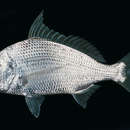Diagnostic Description
(
anglais
)
fourni par Fishbase
Live specimens' head and trunk sides olive-green above, becoming silvery below; snout region blackish dorsally; dorsal fin membrane with faint black blotches or small spots at each spine and ray, just above edge of scaly basal sheath, silvery anteriorly on 1st-5th dorsal spine, grading to hyaline on spinous and soft dorsal fin; anal fin scaly basal sheath silver; distal part of pelvic fin between 1st-5th soft rays often white or hyaline for 1/5-1/3 of ray length, other parts hyaline or slightly yellowish; pectoral and anal fins hyaline. Caudal fin dusky with broad darker margin posteriorly which may be indistinct in old or poorly preserved specimens; ventral edge of lower caudal fin lobe white or bluish-white. Generally, body with prominent dark stripes along scale rows above lateral line (distinct in preserved specimens); 4-9 somewhat oblique dusky bars or columns of ovoid dark spots immediately below lateral line in specimens over 10 cm SL (dusky bars on less than 10 cm) but more apparent in preserved or stressed individuals. Scales between 5th dorsal fin spine base and lateral line 5-6.5 (modally 5.5). Upper jaw extending vertically beyond anteriormost margin of dermal eye opening, sometimes reaching to vertical at anterior margin of pupil. Second dorsal fin spine longest, 17-25% SL (Ref. 41108, 4372). Pre-opercle lower flange scaled. Body depth max 2.3-2.8 in SL. Pectoral fins reaches to or beyond level of anal-fin origin; caudal fin forked deeply (Ref. 90102). Pelvic fin of Red Sea specimens solid yellow with a narrow white distal margin; anal fin with a yellow tinge between the first rays; pectoral fin base with a dark brown spot (Horst Moosleitner, personal communication, homosub@aon.at). Examination of the meristic and morphometric data of the syntypes of G. lineolatus and G. rueppellii, and holotype of G. darnleyense showed all these are subadult or young specimens of G. longirostris (Ref. 41108).
- licence
- cc-by-nc
- droit d’auteur
- FishBase
- Recorder
- Cristina V. Garilao
Migration
(
anglais
)
fourni par Fishbase
Amphidromous. Refers to fishes that regularly migrate between freshwater and the sea (in both directions), but not for the purpose of breeding, as in anadromous and catadromous species. Sub-division of diadromous. Migrations should be cyclical and predictable and cover more than 100 km.Characteristic elements in amphidromy are: reproduction in fresh water, passage to sea by newly hatched larvae, a period of feeding and growing at sea usually a few months long, return to fresh water of well-grown juveniles, a further period of feeding and growing in fresh water, followed by reproduction there (Ref. 82692).
- licence
- cc-by-nc
- droit d’auteur
- FishBase
Morphology
(
anglais
)
fourni par Fishbase
Dorsal spines (total): 9; Dorsal soft rays (total): 10; Analspines: 3; Analsoft rays: 7
- licence
- cc-by-nc
- droit d’auteur
- FishBase
- Recorder
- Cristina V. Garilao
Trophic Strategy
(
anglais
)
fourni par Fishbase
Prefers brackish waters, often found in estuaries and coastal lagoons. Forms schools. Feeds on small bottom invertebrates (Ref. 3409).
- licence
- cc-by-nc
- droit d’auteur
- FishBase
Biology
(
anglais
)
fourni par Fishbase
Adults often in clear coastal waters up to about 50 m depth; juveniles often in estuaries or lagoons influenced by fresh water (Ref. 41108); they prefer shallow waters over sandy bottoms, from coral reefs to brackish waters (Ref. 30573). Fry about 10 cm in length enter the estuaries and stay until they reach maturity (Ref. 34363). Occur singly or in groups (Ref. 9710). Feed on small bottom invertebrates (Ref. 3409). In the Gilberts, the species forms spawning aggregations for a few days around the new moon (Ref. 37816). Sold fresh in markets; processed into fishmeal. Also taken with stake-nets (Ref. 3409).
- licence
- cc-by-nc
- droit d’auteur
- FishBase
Importance
(
anglais
)
fourni par Fishbase
fisheries: commercial
- licence
- cc-by-nc
- droit d’auteur
- FishBase
分布
(
anglais
)
fourni par The Fish Database of Taiwan
分布於印度-西太平洋,西起紅海及非洲東岸,東至西太平洋各群島。台灣分布於北部及西部海域。
利用
(
anglais
)
fourni par The Fish Database of Taiwan
一般以底拖網或流刺綱採獲,魚體小者,常作下雜魚處理,供養殖飼料之用,體型大者市場偶可見到。可生鮮或醃漬處理,適宜煎、炸食用。
描述
(
anglais
)
fourni par The Fish Database of Taiwan
體呈長卵圓形而高,標準體長約為體高的2.5-2.9倍,體背於背鰭起點處略為彎曲,與水平方向軸約呈40度角。口小唇薄,能伸縮自如,伸出時向下垂。眼大,吻尖。上下頜齒細長,呈絨毛狀;鋤骨、腭骨及舌面皆無齒。體被薄圓鱗,易脫落;背鰭及臀鰭基底具鱗鞘;側線完全,呈弧狀,至尾鰭基底之側線鱗數42-44,尾鰭基底之有孔鱗3-5;側線上鱗列數4.5-5.5(側線至背鰭第V棘間,且不含側線鱗)。背鰭單一,硬棘部IX,第II棘最長,但短於頭長;臀鰭第II棘略粗狀狀,長於眼徑長;胸鰭極長,末端可達臀鰭第I棘之後;尾鰭深叉形而長,最長鰭條長較胸鰭為長。體色呈銀白色,體背淡橄欖色;幼魚時,體側具7-8條的橫帶,成魚後,橫帶轉為卵形黑斑;尾鰭具有暗色緣。以前之紀錄--長鰭鑽嘴魚(/Gerres
acinaces/)為本種之同種異名。
棲地
(
anglais
)
fourni par The Fish Database of Taiwan
棲息於沿岸之沙泥底質之水域,經常成群活動。有時會在河口水域出現,甚至河川下游。肉食性,掘食在沙泥地中躲藏的底棲生物。

